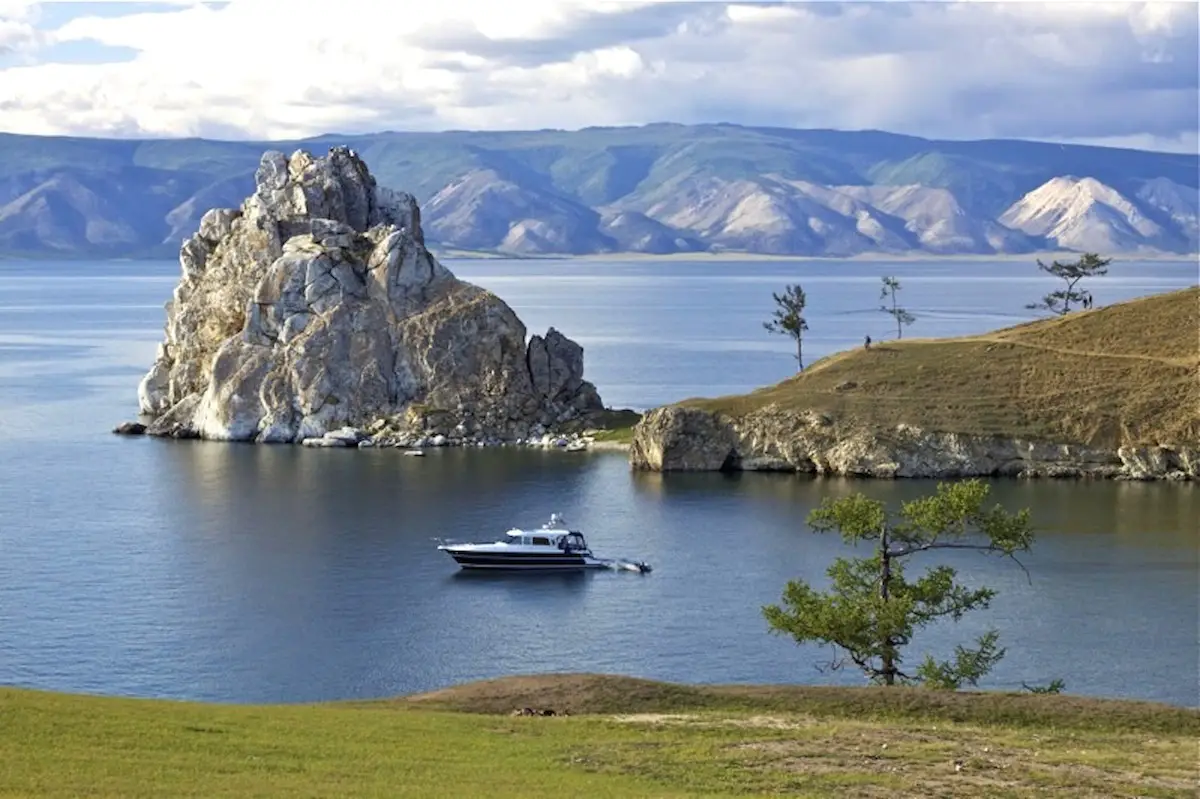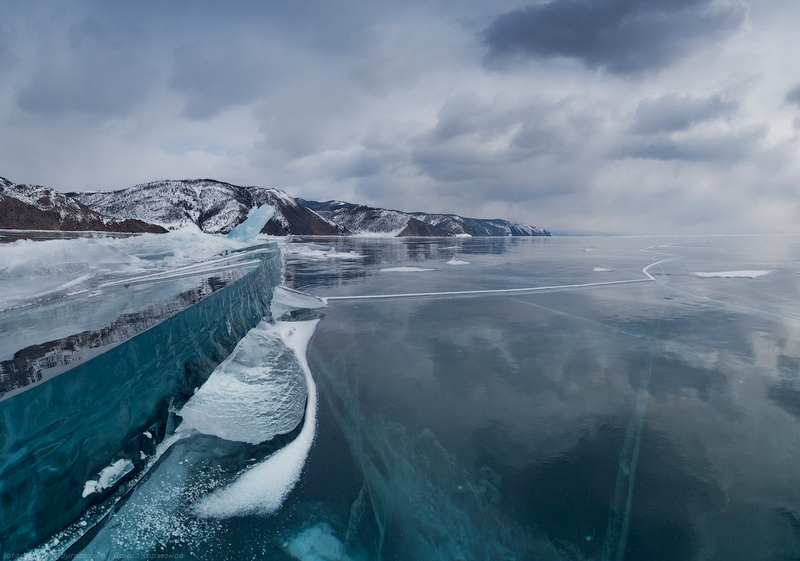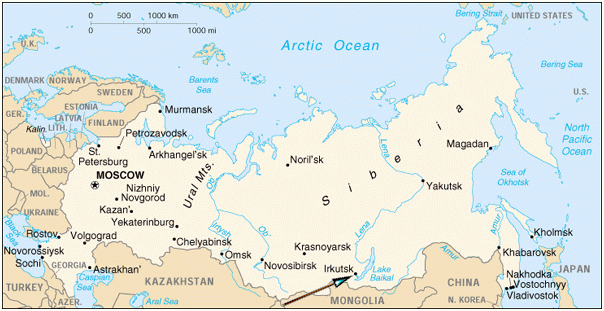Lake Baikal
- Lowest and oldest freshwater lake on Earth
- World Heritage Site since 1996
Lake Baikal (Russian озеро Байкал Ozero Baikal, Buryat of Байгал нуур Baygal nuur " rich lake ", in German as often just called Baikal in Russian ) is a lake in Siberia, Russia ( Asia). He is with 1642 meters, the deepest and with more than 25 million years, the oldest freshwater lake on Earth. His only outlet, the Angara flows over the Yenisei in the Kara Sea of the Arctic Ocean. In 1996, the Baikal region was declared a UNESCO World Heritage Site.
- 2.1 Neutrino Telescope
- 2.2 Limnological Institute
Geography
Location
Lake Baikal is located in the South Siberian mountains on the border between Irkutsk Oblast on the western and northern shores and the Buryat Republic on the eastern and southern shores. Among the high mountains that surround the lake, including the Baikal Mountains on the western and north-western shore, the Stanowoihochland in the Northeast, the Bargusingebirge and the Ulan- Burgassy Mountains on the east bank, the Khamar - Daban mountain range in the south and the Sayan Mountains, the south-west to of the lake rises.
Geographical dimensions
Lake Baikal, the water surface area ( 31,722 km ² ) is located in 455.5 m above sea level, is 25 million years, the oldest and with 1642 m of the deepest lake in the world. The lake has a shore length of about 2125 km, from the southwest to the northeast, 673 km long ( center line of Lake Baikal ) and a maximum of 82 km wide. Its average width is 48 km.
Climate
Around the lake has a continental, relatively mild coniferous forest climate. There are about 2,000 hours of sunshine annually, with the December 77 the sun poorest and June with 275 sun hours of the sunniest month. There are about 450 mm of precipitation annually, which fall in February 9 mm rainfall in July and 120 mm.
The winter (November to March) are with an average temperature of -20 ° C dry - cold, it prevails from early November to late March permafrost. In the mountains around the lake is from mid-September to late June snow while the snow lies in the valleys of mid-November to early April. Temperatures can drop to about -50 ° C.
The spring (April / May ) and autumn (September / October) with only two months short. Night frosts there may be up into June and then again from the end of August already.
The summer (June to August) are relatively warm, with average values of about 15 ° C and daytime temperatures often above 20 ° C. During this time, most of the rain falls.
Hydrology
The Baikal is the largest fresh water reservoir liquid of the earth with one fifth of the liquid freshwater reserves. The lake is equivalent to a volume of 23615.39 km ³, which is thus larger than that of the Baltic Sea and about 480 times the water content of Lake Constance. The catchment area of the lake with its tributaries covers about 1.5 million km ². That's more than four times the size of Germany.
Is fed to the Lake Baikal of 336 rivers and countless streams. The largest rivers are the Upper Angara, the Selenga and the Bargusin. The Angara is now the only outlet of the lake and one of the great rivers of Siberia. Despite their massive runoff the Angara would flow about 400 years, until the Baikal would be emptied.
Geologically, the lake had two more outflows: the first was located a little further north than the Angara and had connection to the bed today's Lena. By orogeny ( Baikal Mountains) this drain was blocked. The second drainage was further south. Due to an earthquake about 16,000 years ago, it was sealed.
Comparison with the Great Lakes of North America
The Great Lakes ( Lake Erie, Lake Huron, Lake Michigan, Lake Superior and Lake Ontario ) together make a water volume of about 22,680 km ³, which corresponds to almost the Lake Baikal, and thus contain the second -fifth of all liquid fresh water on earth. In contrast, the surface of the Great Lakes with a total of about 244,300 km ² siebeneinhalbmal is as large as that of Lake Baikal.
Comparison with the Caspian Sea
The Caspian Sea, with 386.4 thousand km ² water surface and 78,700 km ³ volume as the largest lake is of the earth, each is several times larger than the Lake Baikal in these two dimensions. However, the water of the Caspian Sea is compared to that of Lake Baikal is not a pure fresh water, even if the salt content is lower than in the oceans.
Baikal rift
Lake Baikal is part of a continental grave breach. The so-called Baikal rift that has developed into a grave break for millions of years of a weakened zone, extends and deepens still by approximately 2 cm per year.
Because this drift apart the Eurasian plate and the amurische, cracks in the earth's crust; This is due to the collision of the far south upstream Indian plate, which presses apart like a wedge, the aforementioned plates. The zone of the Baikal - trench, which has the greatest weakness is in the area of Lake Baikal.
The plan, in which the lake is located, is about 1600 km long, filled nearly 6 km deep and sediments. Therefore, the Baikal reaches "only" up to 1642 m depth. This is the deepest lake in the world their deepest cryptodepression.
A variety of hot springs and increased seismic activity indicate that the crust in this region is very active.
Islands
Within the Lake Baikal there are 22 major islands and numerous islets along its banks and protruding from the water rocks. Its largest island Olkhon ( Ol'chon; near the west bank, 730 km ² and 72 km long), whose mountains to 1276 m ( 821 m above the level of the lake ). The largest peninsula of the lake is Svyatoi Nos on the east bank (literally " Holy nose ", where Nos often stands in Russian for headlands or capes ), whose mountains to 1636 m high tower ( 1181 feet above the level of the lake ) and the example in the Seemitte the Uschkanji Islands are offshore.
Olkhon Island ( Ol'chon )
Olkhon Island at Shamanka
Conservation
After the Second World War, the industrialization in the area of the lake has been driven, which was made possible mainly by the Trans-Siberian Railway and the Baikal - Amur Mainline. To this end, they built paper and pulp mills in Baykalsk (1966) and Selenginsk. It also began to fish the lake excessive. Due to the increasing industrialization of the cities grew on the lakeshore, especially Baykalsk. The waste water of the city and the industry are passed untreated into Lake Baikal. Both contribute significantly to pollution of the local environment, so the lake water as well as the soil and air.
The paper and pulp mill in Baykalsk received in 2003 a loan from the World Bank, according to information provided by Greenpeace in the amount of 22.4 million U.S. dollars to finance the then estimated 33.5 million U.S. dollars modernizing the plant. Since the implementation of the reconstruction plan had remained poor, the World Bank in 2005 pulled back the loan again. The governor of the Irkutsk Region promised 2009, the closure of the plant. This decision was, however, revised by Prime Minister Putin, which led to protests by environmental experts.
The landscape at the Baikal is threatened by the use of forests in the form of clear cuts, which greatly change the appearance near the lake. The shore is increasingly being built by newly rich Russians, dachas, often under the circumvention of national or regional laws for nature and landscape protection.
To counteract the destruction of the landscape and the nature of the Baikal region, nature reserves and national parks have been partly established in many places. On the central western shore of Lake Baikal is the Lena Nature Reserve, on the opposite, the Bargusin Nature Reserve spreads to which connects to the south of the Trans- Baikal National Park. At the south end of the lake the Baikal Nature Reserve was established. From the located on the western shore of Olkhon island until a few kilometers off the south end of the lake, the Cisbaikal National Park spreads. In addition, the Lake Baikal is entirely surrounded by a coastal protection zone.
In 1996, the huge Baikal region by UNESCO as a World Heritage Site was included in the World Heritage List.
Infrastructure
Towns
At the lake villages and near the Lake Baikal include:
- Babuschkin - small town on the southeastern shore
- Baykalsk - at the extreme southern shore
- Baikalskoje - on the northwest shore, the administrative center of Baikal Evenki - Nationalrajons
- Khuzhir - on the island of Olkhon
- Irkutsk - off the southwest shore of the Angara (60 km downstream )
- Listvyanka is located 70 km south-east from Irkutsk to the point where the Angara River flows out of Lake Baikal
- Nischneangarsk - at the north end, the administrative center of Rajons Sewerobaikalsk
- Selenginsk - off the southeast shore, at the mouth of the Selenga Delta (50 km upstream )
- Sewerobaikalsk - on the northwest shore, opposite the mouth of the Upper Angara
- Slyudiyanka - at the southwest end
- Ust- Bargusin - on the eastern shore, at the mouth of Bargusin
Traffic
The among others, with the localities just mentioned usually still relatively sparsely populated Baikal region, especially the area of Lake Baikal is usually opened only a few streets near the shore. At the north end of the lake is affected by the route of the Baikal - Amur Mainline and in the south of that of the Trans -Siberian Railway. In Irkutsk and Ulan -Ude are important airfields.
When the Lake Baikal is frozen over in winter, it is used as a road. Some places on Baikal and the islands are accessible mentioned icy roads in winter only on these " zimnik ".
Nowadays " drift " ( slide ) the young Russians with their cars on the ice surface or can be drawn on a sled by a car on the ice surface.
Research
Neutrino telescope
Lake Baikal is located in approximately 1,100 meters water depth, the neutrino telescope BDUNT. The complex consists of 192 light sensors, which are arranged cylindrical ( height, 80 meters, diameter 50 meters). The telescope is the study of neutrinos.
Limnological Institute
The belonging to the Irkutsk Scientific Center Limnological Institute of the Siberian Branch of the Russian Academy operates in Listvyanka a museum dedicated to the flora and fauna of Lake Baikal. Scientists from this institute also found an explanation for the phenomenon of Eiskreise.
Flora and Fauna
Lake Baikal and its environment has a unique flora and fauna: About two-thirds of the 1,500 animal and 1,000 plant species are endemic, ie occur only here. As the lake is steadily deeper, the animals had plenty of time to adapt, resulting in a high diversity of species is also found in 1.6 km depth.
Here lives a world of only two occurring in freshwater seal species, the Nerpa or Baikal Seal. The cisco, a Maränenart, and the Golomjanka, a fat fish, the lowest occurring freshwater fish on earth, are also present here. This is made possible, among other things due to the low water temperature of the lake, which is on the surface throughout the year, only about 7 ° C. In cold water, more oxygen can be dissolved. In total there are 128 species of fish in Lake Baikal, two of which are endemic: the deepwater sculpin ( Abyssocottidae ) and the Baikal oil fish ( Comephoridae ).
The water of Lake Baikal is constantly cleared in a natural way, so that its purity is extremely high. For his keeping clean tiny amphipods care ( 230 species, representing 90 % of the biomass of the lake). Of particular note is a tiny cancer, the Baikal- Epischura ( Epischura baikalensis ), which destroyed the smallest algae and bacteria. This cancer is only one and a half millimeters long, but on a square kilometer of water layer include scientists sometimes up to three million of these animals. Another, somewhat larger amphipod, which is called by the local inhabitants Jur ( Macrohectopus branickii ) can destroy dead fish, drowned insects and even terrestrial vertebrates.
The surrounding 20,000 km ² national park can be found among others lynxes, bears, deer and wolves.
Tourism
The village of Listvyanka is best developed for tourism with restaurants, hotels and roads. A leading around Lake Baikal long-distance footpath, the Great Baikal Trail, is emerging. Because of the enormous amount of water of the lake, the water temperature rises even in July and August scarcely above 10 ° C, making the lake therefore only a very few flat areas and suitable for bathing. It is completely frozen over from mid- November to early May.
On the basis of the law of 2005 on the establishment of special economic zones in Russia are also tourist special economic zones under construction, two of which occur on Lake Baikal.
- In Irkutsk Region is created on the western Baikal shore in the village Bolschoye Goloustnoe, north of Listvyanka, a tourism zone. The concept was confirmed in April 2009.
- A second tourism special economic zone located since 2007 on the eastern bank of Lake Baikal in Buryatia in the region between the villages of Turka and Peski directly opposite the island of Olkhon under construction.
- 2009, the long-distance hiking Frolikha Adventure Coastline Track ( FACT) was reported on the northeastern shore of the lake.










